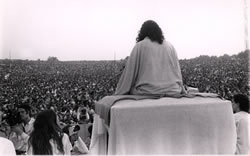Swami Satchidananda (Dec. 22, 1914 – Aug. 19, 2002) was a spiritual teacher and founder of the Integral Yoga International. He taught that “The goal and the birthright of all individuals is to realize the spiritual unity behind the diversity throughout creation and to live harmoniously as members of “one universal family”.
Short bio Swami Satchidananda
Swami Satchidananda was born into a loving spiritual family on December 22nd in 1914 during the month known as Margali, the Dawn of the Devas. His parents were Sri Kalyanasundaram Gounder and his wife Srimati Velammai.
From an early age, Swami Satchidananda ( or Ramaswamy as he was known at the time) displayed many spiritual tendencies and a dedication to the truth. He says he felt an absence of attachment to material objects.
“Somehow I can’t recollect anything I was attached to very much, even as a youth. I had the same affection toward everybody and everything.”
In particular, he drew no distinction between people of different castes even though at the time the caste system was of great significance in influencing people. Ramaswamy was always quick to denounce the caste system and didn’t appreciate the complicated arguments put forward by his elders.
“No person is an untouchable. Differences come, not with the work one does nor the caste into which one is born, but with the state of mind. Essentially we are all one and the same. All are God’s children.”
As a young man, he studied at an agricultural college and then travelled to Sri Lanka to work as an engineer in the automobile industry. For a short time, Ramu also served as the Temple Manager of the Perur temple and here he fell in love with a beautiful and devout daughter of one of the administrators. However, after 5 years his wife suddenly passed away. Swami Satchidananda writes that somehow this death didn’t come as a shock, he had had a premonition that this might occur. He said
“I loved my wife, but at the same time, I wasn’t attached to her.”
However, this experience and others led the young Ramu to take a greater interest in yoga and spirituality. Swami Satchidananda thus at the age of 28 eventually decided to give up his successful worldly career in order to devote himself full time to spiritual practices. He writes that this decision to renounce the world was not about giving things up as much as gaining a new perspective on life.
“By renouncing the world, you don’t lose anything. Once you give yourself to others, all others will give themselves to you.”
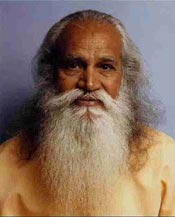
In his many writings, he often stressed the sincere gratitude he felt towards the loving guidance of his Guru, Swami Sivananda. He learnt many things but said the primary teaching of his Guru was that of service to others.
“Always try to serve others. Don’t even call it helping; call it service because you are benefiting by that.”
Although a sannyasin Swami Satchidananda was active in serving others and was quite happy to use modern technology to disseminate the teachings of yoga. He undertook an arduous lecture tour of India and in 1953 was invited to Sri Lanka where he helped to run an ashram of the Divine Life Society near Trincomalee. Here he proved to be a much loved spiritual guide and was looked up to as a Guru. He also became well respected for his universalist approach to religion. Like many other great Saints of India, Swami Satchidananda believed all religions could lead sincere seekers to the same goal. His interfaith motto was the principle that “Truth Is One, Paths Are Many.” It was also during this time that he decided to make an arduous pilgrimage to the Holy Mountain Mount Kailash in the Himalayas. He felt he succeeded only due to the grace of Lord Shiva.
In 1966 the artist and disciple Peter Max invited him to New York city this led on to Swami Satchidananda deciding to stay in America becoming an American citizen. In the west, he initiated many western seekers into the order of sannyasin and lectured at many different locations throughout the world. He often participated in interfaith initiatives. His mission was to bring people together in the spirit of friendship and harmony. An iconic moment of the 1960s was Swami Satchidananda’s opening meditation at the Woodstock Festival of 1969
Swami Satchidananda at Woodstock 1969
For his work and service in the West, Swami Satchidananda received many awards includes the U Thant award presented by Sri Chinmoy on behalf of the United Nations Meditation group. Other awards included the Martin Buber Award for Outstanding Service to Humanity, the Juliet Hollister Interfaith Award, the B’nai Brith Anti-Defamation League’s Humanitarian Award, and the Albert Schweitzer Humanitarian Award
Swami Satchidananda is the founder of the Integral Yoga Institute whose 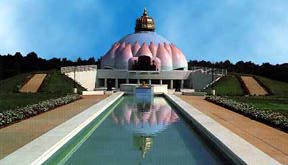
Citation: Pettinger, Tejvan. “Biography of Swami Satchidananda“, Oxford, UK – www.biographyonline.net. Published 12th Jan. 2013. Last updated 1 March 2018.
The Essential Teachings of Swami Satchidananda at Amazon
Related pages
 Famous Indians – A list of Indian men and women throughout the ages. Categories include politicians, scientists, sports people, spiritual figures and cultural figures. Includes Mahatma Gandhi, Akbar, Swami Vivekananda and Indira Gandhi.
Famous Indians – A list of Indian men and women throughout the ages. Categories include politicians, scientists, sports people, spiritual figures and cultural figures. Includes Mahatma Gandhi, Akbar, Swami Vivekananda and Indira Gandhi.
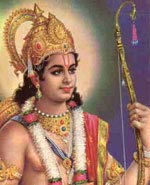
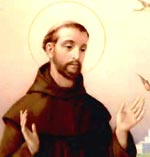
- Spiritual teachers
- How to Be Happy by Swami Satchidananda
Links

